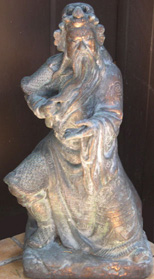Materials: Bronze and brass
Brasses and Bronzes are probably the most well-known families of copper-base alloys. Brasses are mainly copper and zinc. Bronzes are mainly copper along with alloying elements such as tin, aluminum, silicon or beryllium.
Materials: Bronze
By far the preferred copper alloy in antiquity was bronze. Bronze is an alloy of copper and tin, usually in roughly a nine-to-one ratio. In some cases additional elements were added as well. As noted, copper itself is quite a soft metal, and only marginally useful for tools, but the introduction of tin much increases its hardness as well as making casting easier.
 |
| Because of its high copper content, bronze, normally reddish in color, gradually develops a blue-green patina as the surface interacts with oxygen and other elements in the air. The unstable patina can be often be rubbed off and may therefore be uneven if some areas are more frequently rubbed or are protected from abrasion or from the elements, as shown in this XXth-Century Chinese Bronze Figure Private Collection |
Copper is found in many places in the world, although not universally. Tin, in contrast, is actually rather rare. Thus the production of bronze depends upon felicitous location or successful trade, and it was always a luxury product in the ancient world, even when "useful" products were made from it. Control of copper and tin mines, and of associated trade routes, therefore became important to the wealth and prestige of many peoples, and, when bronze weapons came into general use, important to their security as well.
Antimonial Bronze
The introduction of antimony in addition to the tin and copper produces a harder bronze, better able to hold a cutting edge and less likely to be bent in use.
Arsenical Bronze
Like antimony, arsenic added to the tin and copper (up to as much as 3% of the whole) produces a harder final product. Arsenic fairly routinely occurs as an impurity in early bronze anyway, and small amounts of it were probably not intentional or particularly noticeable in the final product. By the time the proportion of arsenic in bronze reaches two or three percent, however, the effects are quite noticeable and presumably intentional. It is to these products that the term "arsenical bronze" is usually applied.
Lead Bronze
Mixing lead into the copper-tin alloy produces "lead bronze," which may contain as much as 10% lead. The lead in the alloy does not become part of its crystalline structure, increasing the fluidity of compound when it is in its molten state. This facilitates casting, particularly the casting of finely detailed artistic objects. However lead bronze is softer than normal bronze, and therefore less able to hold a cutting edge, making it less appropriate for many types of tools.
Increasing the amount of tin in the alloy much above 10% produces greater brittleness, and tools made that way easily break. However alloys with more tin —potin (up to 20% tin) and speculum (more than 30% tin)— were used for early coins in some parts of Europe, where brittleness was not a significant problem.
The term "Bronze Age" refers to those periods around the world in which bronze was in general use. The specific dates of course vary from region to region, and vary also with the rigidity with which one defines "general use." The Bronze Age in any given place is considered to have come to an end when the generalization of iron brought on the beginning of the Iron Age, an equally problematic term.
Brass
Brass is an alloy of copper with zinc, and is usually made up of anywhere from ten to forty percent zinc. Small amounts of other ores produce special-purpose brass. (Tin and aluminium increase resistance to corrosion, for example.) Zinc ore (called calamine) is difficult to mix with the copper ore, however, and brass appears later in the archaeological record as well as being far less common than bronze.
Sources: http://www.copper.org
http://weber.ucsd.edu
In our offer we have:
● Copper tubes for LPG vehicles ![]()
Click on the links above to see more product details.
For information for sizes and prices please email us at info@copper-tubes.net
or telephone us on +381(0)11 3970 300
 sitemap
sitemap
Search
eng rus ger pol ita ned swe jpn srb cro esp chi por kor hun fra
Product range
- Copper tubes and pipes:
-
 Soft copper tubes
Soft copper tubes -
 Half-hard copper tubes
Half-hard copper tubes -
 Hard copper tubes
Hard copper tubes -
 PVC coated copper tubes
PVC coated copper tubes
-
 Copper pipes for LPG
Copper pipes for LPG -
 Tubes for refrigeration and AC
Tubes for refrigeration and AC Tubes for plumbing
Tubes for plumbing -
 Capillary tubes
Capillary tubes -
 Conductors, cables and wire
Conductors, cables and wire -
 Enamelled copper wire
Enamelled copper wire -
 Copper bars, rods and plates
Copper bars, rods and plates Brass and bronze bars and tubes
Brass and bronze bars and tubes -
 Copper strips and sheets
Copper strips and sheets -
 Copper, bronze, brass ingots
Copper, bronze, brass ingots -
 Trolley wire
Trolley wire -
 Copper fittings (pdf)
Copper fittings (pdf) -
 Contact details
Contact details -
 Careers
Careers
Other products:
Interesting facts
-
 Tables of standards
Tables of standards -
 Copper through history
Copper through history -
 Application of copper tubes
Application of copper tubes -
 Advantages of copper tubes
Advantages of copper tubes -
 Copper ore
Copper ore -
 Brass and bronze
Brass and bronze -
 Copper-containing minerals
Copper-containing minerals -
 Copper facts
Copper facts -
 Symbols of copper
Symbols of copper -
 Copper coins
Copper coins -
 The Baghdad Battery
The Baghdad Battery -
 Links
Links